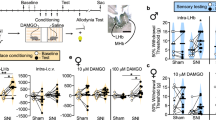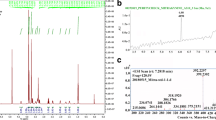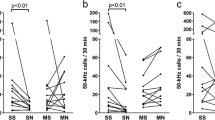Abstract
μ Opioids have been shown to produce analgesia and to be reinforcing during the first week of life in the rat. κ Opioids also have analgesic actions in both the infant and adult, but can be aversive in the mature animal. We examined the aversive effects of the κ opioid agonist U50,488 during the first postnatal week in the rat pup in three ways. In the first experiment, U50,488, injected peripherally (1.0–30.0 mg/kg), was paired with an odor and pups were tested 8 h later for positional preference for avoidance of that odor. This task is similar to conditioned preference/aversion tests used with adult animals. Both 3- and 7-day-old pups learned to avoid the odor adulterated side at the two higher doses. When exposed to odors previously associated with U50,488, pups at both ages decreased locomotor activity. In a second experiment, acute treatment with U50,488 increased ultrasonic distress vocalizations (USV) equally at 3 and 7 days of age, increased locomotor activity, and decreased rectal temperature. Neither of the latter two effects was correlated with the increase in USV production. The third experiment showed that conditioned odor cues increased USV 8 h later in 3- and 7-day-old pups at 1.0–10.0 mg/kg without changes in activity or rectal temperature. The results from these studies suggest that U50,488 can produce aversions in the neonatal rat pup as it does in the adult.
Similar content being viewed by others
References
Allerton CA, Smith JAM, Hunter JC, Hill RG, Hughes J (1989) Correlation of ontogeny with function of [3H]U69593 labelled kappa opioid binding sites in the rat spinal cord. Brain Res 502:149–157
Bals-Kubic B, Herz A, Shippenberg TS (1989) Evidence that the aversive effects of opioid antagonists and κ-agonists are centrally mediated. Psychopharmacology 98:203–206
Barr GA (1992) The behavioral effects of opiates during development. In: Miller MW (ed) Development of the central nervous system: effects of alcohol and opiates. Wiley, New York, pp 221–254
Barr GA (1993) Reinforcement properties of opiates during early development. In: Hammer RP Jr (ed) The neurobiology of opiates. CRC Press, Boca Raton, Fla, pp 63–83
Barr GA, Rossi G (1992) Conditioned place preference produced by local injection of morphine into the ventral tegmental area of 3-day old rats. Dev Brain Res 66:133–136
Barr GA, Wang S (1992) Peripheral and central administration of cocaine produce conditioned odor preferences in the infant rat. Dev Brain Res 599:181–185
Barr GA, Paredes W, Erickson KL, Zukin RS (1986) K-opioid receptor-mediated analgesia in the developing rat. Dev Brain Res 29:145–152
Bechara A, Kooy K van der (1987) Kappa receptors mediate the peripheral aversive effects of opiates. Pharmacol Biochem Behav 28:227–233
Benton D (1988) The role of opiate mechanisms in social relationships. In: Lader MH (ed) The psychopharmacology of addiction. Oxford University Press, New York, pp 115–140
Blumberg MS, Alberts JR (1990) Ultrasonic vocalizations by rat pups in the cold: an acoustic by-product of larynegeal braking? Behav Neurosci 104:808–817
Carden SE, Barr GA, Hofer MA (1991) Differential effects of specific opioid receptor agonists on rat pup isolation calls. Dev Brain Res 62:7–22
Carden SE, Bortot AT, Hofer MA (1993) Ultrasonic vocalizations are elicited from rat pups in the homecage by pentylenetetrazol and U50,488, but not naltrexone. Behav Neurosci (in press)
DeCasper AJ, Fifer WP (1980) Of human bonding: newborns prefer their mothers' voices. Science 208:1174–1176
DiChiara G, Imperato A (1988) Drugs abused by humans preferentially increase synaptic dopamine concentrations in the mesolimbic system of freely moving rats. Proc Natl Acad Sci 85:5274–5278
Helmstetter FJ, Calcagnetti DJ, Cramer CP, Fanselow MS (1988) Ethylketocyclazocine and bremazocine analgesia in neonatal rats. Pharmacol Biochem Behav 30:817–821
Hofer MA, Shair HN (1991) Independence of ultrasonic vocalization and thermogenic responses in infant rats. Behav Neurosci 105:41–48
Hofer MA, Shair HN (1993) Ultrasonic vocalization, laryngeal braking and thermogenesis in rat pups: a reappraisal. Behav Neurosci 107:354–362
Hoffman DC (1989) The use of place conditioning in studying the neuropharmacology of drug reinforcement. Brain Res Bull 23:373–387
Iwamoto ET (1986) Place-conditioning properties of mu, kappa and sigma opioid agonists. Alcohol Drug Res 6:327–339
Jackson HC, Kitchen I (1989) Behavioural effects of selective μ-, κ-, and δ-opioid agonists in neonatal rats. Psychopharmacology 97:404–409
Kehoe P, Blass EM (1986) Central nervous system mediation of positive and negative reinforcement in neonatal albino rats. Dev Brain Res 27:69–75
Kehoe P, Boylan C, Shoemaker W (1990) Differential effects of specific endogenous opioid systems on affective behaviors in neonatal rats. Neurosci Abstr 16:211
Leslie FM, Loughlin S (1993) In: Hammer RP Jr (ed) The neurobiology of opiates. CRC Press, Boca Raton, Fla, pp 85–113
McDowell J, Kitchen I (1987) Development of opioid systems: peptides receptors and pharmacology. Brain Res Rev 12:397–421
Mucha RF, Herz A (1985) Motivation properties of kappa and mu opioid receptor agonists studied with place and taste preference conditioning. Psychopharmacology 86:274–280
Panksepp J, Siviy S, Normansell L (1985) Brain opioids and social emotion. In: Reite M, Fields T (eds) The psychobiology of attachment and separation. Academic Press, New York, pp 3–49
Pedersen PE, Blass EM (1982) Prenatal and postnatal determinants of the 1st suckling episode in albino rats. Dev Psychobiol 15:349–355
Rudy JW, Spear NE (1991) Tests of the ontogeny of learning and memory: issues, methods, and results. In: Shair HN, Barr GA, Hofer MA (eds) Developmental psychobiology: new methods and changing concepts. Oxford University Press, New York, pp 84–113
Shippenberg TS, Herz A (1986) Differential effects of μ- and κ- opioid agonists on motivation processes. NIDA Res Monogr 75:563–566
Smotherman WP (1982) Odor aversion learning by the rat fetus. Physiol Behav 29:769–771
Spencer RL, Hruby VJ, Burks TF (1988) Body temperature response profiles for selective mu, delta and kappa opioid agonists in restrained and unrestrained rat. J Pharmacol Exp Ther 246:92–101
Stickrod G, Kimble DP, Smotherman WP (1982) Met-enkephalin effects on associations formed in utero. Peptides 3:881–883
Winslow JT, Insel TR (1991) The infant rat separation paradigm: a novel test for novel anxiolytics. Trends Pharmacol Sci 12:402–404
Von Voightlander PF, Lahti RA, Ludens JH (1983) U50,488: selective and structurally novel non-mu (kappa) opioid agonist. J Pharmacol Exp Ther 224:7–12
Yaksh TL (1986) The effects of intrathecally administered opioid and adrenergic agents on spinal function. In: Yaksh TL (ed) Spinal afferent processing. Plenum Press, New York, pp 165–195
Author information
Authors and Affiliations
Additional information
Supported by U.S.P.H.S. grant DA-06600
Rights and permissions
About this article
Cite this article
Barr, G.A., Wang, S. & Carden, S. Aversive properties of theκ opioid agonist U50,488 in the week-old rat pup. Psychopharmacology 113, 422–428 (1994). https://doi.org/10.1007/BF02245218
Received:
Revised:
Issue Date:
DOI: https://doi.org/10.1007/BF02245218




